New Hampshire is known for its stunning natural beauty, including rolling hills, lush forests, and sparkling lakes. The state’s rich biodiversity is also home to a variety of bird species, including striking and elusive blue birds. These birds are known for their vibrant blue plumage and unique behaviors and are a favorite among birdwatchers and nature enthusiasts alike. In this blog post, we’ll explore the world of blue birds in New Hampshire, from their preferred habitats and migratory patterns to the best locations for observing them in the wild. Whether you’re an avid birder or simply curious about the natural world, join us as we discover the fascinating world of blue birds in New Hampshire and learn more about the importance of these beautiful creatures in the state’s diverse ecology.
Types of Blue Birds in New Hampshire:
- Barn Swallow
- Belted Kingfisher
- Blue Jay
- Eastern Bluebird
- Indigo Bunting
- Purple Martin
- Red-breasted Nuthatch
- Rock Pigeon
- Tree Swallow
- White-Breasted Nuthatch
Barn Swallow
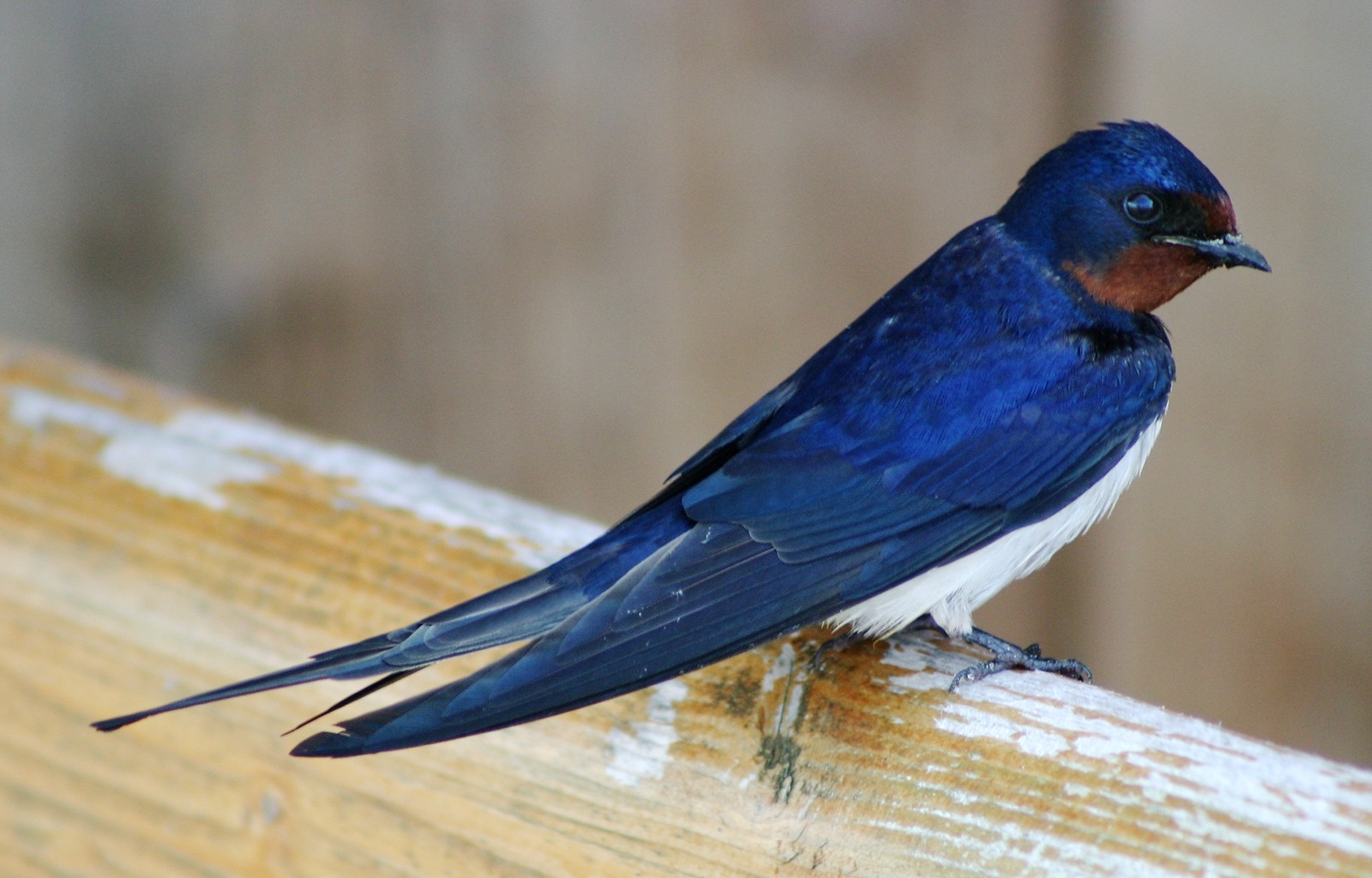
Image Source
- Scientific name: Hirundo rustica
- Lifespan: 4 years
- Size: 5.5 and 7 inches
- Native to: Europe, Asia, Africa, and the Americas
The barn swallow is a small bird with a distinctive appearance. It measures about 7 inches in length and has shiny steel-blue feathers on its back. Its forehead and throat are chestnut in color, while its underparts are a rusty-orange shade. One of its noticeable features is its long forked tail, which has a white base. It’s worth noting that the female barn swallow has lighter coloring and a shorter tail compared to the male.
When it comes to their diet, barn swallows primarily feed on insects, with a preference for beetles, wasps, and flies. They have a unique way of getting a drink by skimming the surface of the water, but they are not typically seen visiting bird feeders.
These birds are commonly found in open fields and pastures, where they build their nests. Barn swallows prefer manmade structures such as barns for nesting. They construct their nests using mud. During the breeding season, they produce two broods, each containing 4-5 white eggs with brown markings. The incubation period for these eggs ranges from 13 to 17 days.
Barn swallows are migratory birds. In the spring, they migrate north to the United States and Canada for breeding and raising their young. When autumn arrives, they head south to the southern states of Mexico. However, some barn swallows remain in central Mexico throughout the year, maintaining a year-round range there.
Belted Kingfisher (Crested Bluebirds In Florida)

Image Source
- Scientific name: Ardea alba
- Lifespan: 15 years
- Size: 3 feet
- Native to: Asia, Africa, the Americas, and southern Europe
The belted kingfisher is a relatively large bird, measuring about 13 inches in length. It has a distinctive appearance with a large head, a long bill, and a stout body. The bird is predominantly blue-gray in color with a white ring around its neck and a white chest. However, the female belted kingfisher is similar in appearance to the male but features an additional chestnut band on her chest.
When it comes to their diet, belted kingfishers primarily feed on fish. They are not commonly seen at bird feeders but are often attracted to areas with streams or ponds.
These birds are typically found in habitats near bodies of water, including streams, rivers, ponds, lakes, and calm marine waters, especially those with clear water and minimal vegetation.
For nesting, belted kingfishers dig burrows along the water’s edge. They usually have 1-2 broods per season, each containing 5-8 large, glossy white eggs that are about 1.5 inches long. The incubation period for these eggs lasts for approximately 22-24 days.
Belted kingfishers are known for their migratory behavior, although not all of them migrate. In the spring, migratory individuals head north to places like Montana, North Dakota, northern Minnesota, Canada, and Alaska for breeding and raising their young. When fall arrives, these migratory birds head back south, sometimes as far as Arizona, New Mexico, southern California, and Mexico.
While many belted kingfishers migrate, some choose to stay in their year-round range, which includes all U.S. states except North Dakota and Arizona, as well as the Pacific coast of Canada’s British Columbia. During the winter, some remain in their year-round range, while others continue their migration south to escape the cold temperatures.
Blue Jay
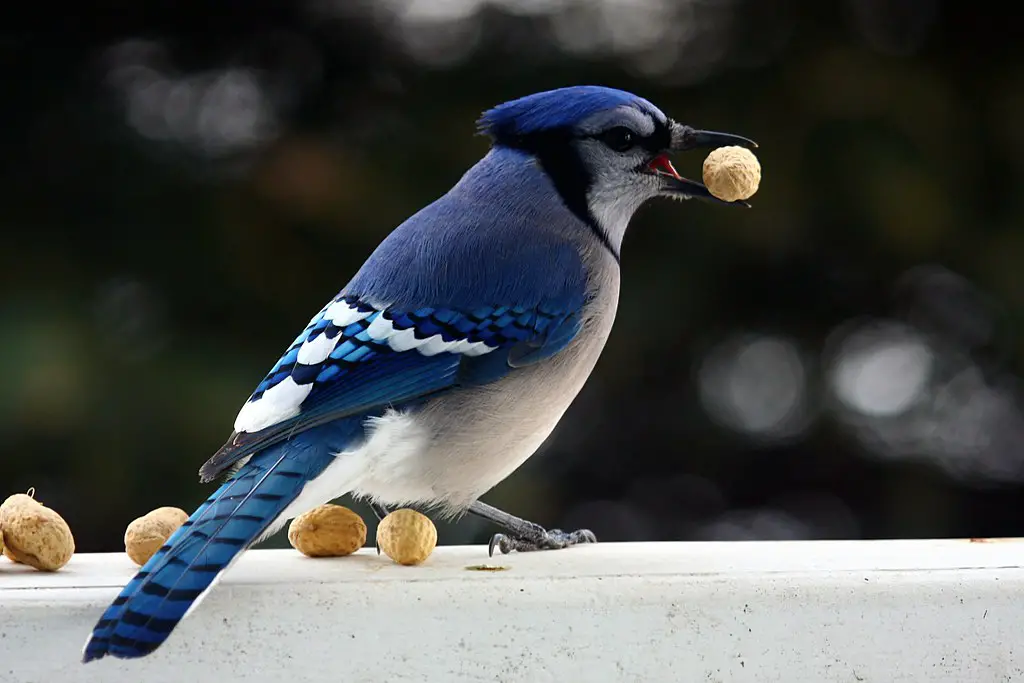
Image Source
- Scientific name: Cyanocitta cristata
- Lifespan: about 7 years
- Size: 9 and 12 inches
- Native to: North America
The blue jay is a large bird, measuring about 12 inches in length. It has a medium blue and white body with distinctive features like a blue crest on its head, which it can flatten at will. The bird also sports a gray belly and a white face. Its wings are a combination of white and blue with noticeable black spots. Interestingly, both male and female blue jays share the same appearance.
When it comes to their diet, blue jays are omnivorous, which means they eat a variety of foods. They enjoy insects, fruits, seeds, nuts, and they are not averse to consuming other birds’ eggs and nestlings.
For those interested in attracting blue jays to their yards, offering whole peanuts, sunflower seeds, and cracked corn can be enticing.
Blue jays are quite adaptable when it comes to their habitat. They are commonly found in forested areas with mixed types of trees, but they are also a frequent sight in suburban and urban environments.
When it comes to nesting, blue jays build substantial nests made from twigs, bark, and mud, typically resting on tree branches at heights ranging from 5 to 50 feet. During the breeding season, they tend to have 1-2 broods, and each brood can contain 2-7 eggs. The eggs of blue jays vary in color from pale blue to a light brown base, often adorned with brown or gray spots. These eggs are relatively small, measuring about 1 inch by just under 1 inch. Both parents share the responsibility of incubating the eggs, which takes about 17-18 days. The young birds, or fledglings, typically leave the nest between 17 to 21 days after hatching.
Blue jays are known for being non-migratory birds. They tend to stay within their year-round range throughout all four seasons, including the breeding season. While they may move around within this range, they do not have a regular pattern of migrating north for breeding and south for the winter, as some other bird species do. However, in rare instances, some blue jays may venture west of their year-round range during the winter months.
Indigo Bunting
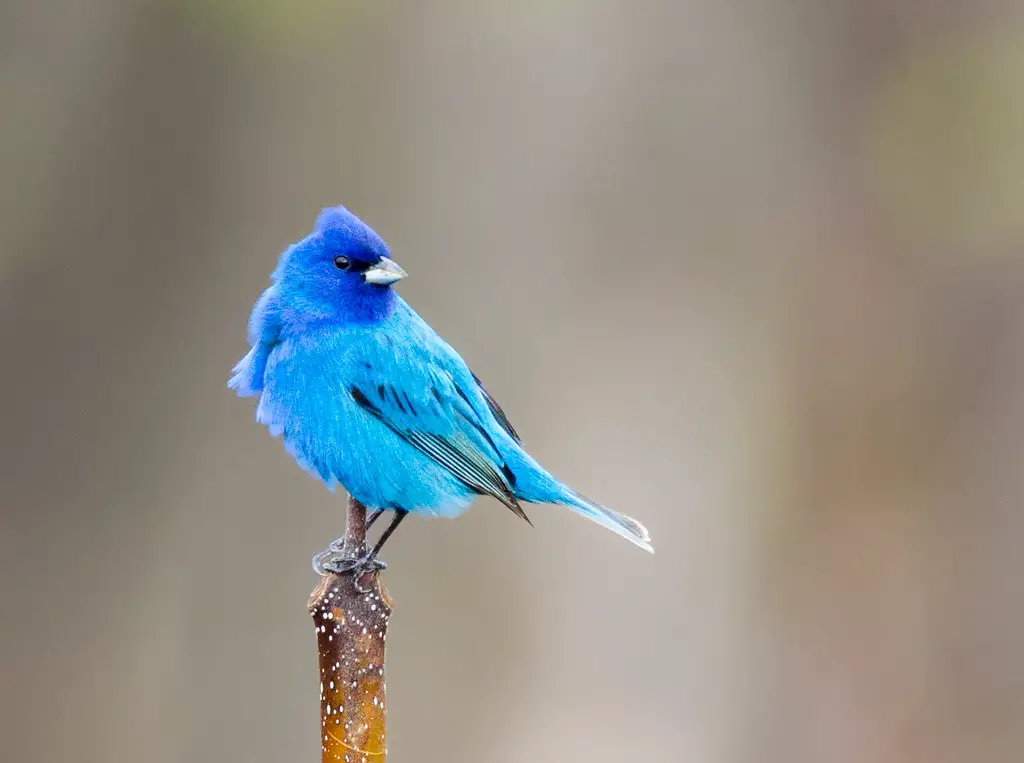
Image Source
- Scientific name: Passerina cyanea
- Lifespan: 10 years
- Size: 5 inches
- Native to: Southern Canada to northern Florida during the breeding season, and from southern Florida to northern South America during the winter.
Indigo Buntings are commonly found in a variety of habitats. You can spot them in brushy fields, where they often perch on weedy plants, scrub areas, and along the edges of woodlands. They also make themselves at home in clearings within deciduous woods and along the edges of swamps.
When it comes to their diet, savannah sparrows have a diverse menu. They typically feed on small seeds, insects, and fruits. While they are not regular visitors to bird feeders, you may attract them by offering nyjer/thistle and white millet seeds.
Their preferred habitat includes brushy fields, weedy plants, scrubland, and woodland edges, as well as clearings within deciduous woods and swampy areas.
For nesting, Indigo Bunting create cup-shaped nests, which they usually place in shrubs or trees about 3 feet high off the ground. During the breeding season, they tend to have 1-3 broods, with each brood containing 3-4 eggs. These eggs are white with a few brown spots.
Purple Martin

- Scientific name: Progne subis
- Lifespan: about 5 to 7 years
- Size: 7-inch
- Native to: North America
The Purple Martin is a medium-sized bird, approximately 8.5 inches in length, known for its distinct appearance. It boasts a blue-purple head, back, and belly, along with black wings and tail.
In terms of diet, Purple Martins primarily feed on insects, with a particular fondness for dragonflies.
Although they are not commonly seen at bird feeders, Purple Martins are known to be social birds and are usually found within 100 feet of human dwellings. They often exist in large colonies, where multiple birds live together.
When it comes to nesting, Purple Martins are cavity nesters, meaning they nest in cavities or hollow spaces. They primarily utilize manmade nest boxes designed to accommodate a colony of birds. During the breeding season, they typically have one brood, which consists of 4-5 white eggs. The incubation period for these eggs lasts for approximately 15-18 days, and the young birds, or fledglings, typically leave the nest after 26-30 days.
Purple Martins are migratory birds. They spend their winters in South America and migrate north during the breeding season to raise their young.
Their breeding range includes the Pacific northwest coast of Washington, Oregon, and California, as well as parts of Arizona, Utah, and Colorado. They are also found in the eastern half of the United States and the southern parts of Canada’s Alberta, Manitoba, Saskatchewan, and Ontario. During the winter months, Purple Martins can be found in South America.
Red-breasted Nuthatch

- Scientific name: Sitta canadensis
- Lifespan: 6 years.
- Size: 4.5 in
- Native to: North Americ
The Red-Breasted Nuthatch is a small bird, measuring about 4.5 inches in length. These birds have distinctive features, including grayish-blue backs, a white head adorned with black stripes over each eye, and an orange-cinnamon-colored breast. They also have a pointed, pick-like beak. Female Red-Breasted Nuthatches share a similar appearance, but their undersides tend to have more muted colors. You’ll often spot them climbing upside-down on deciduous trees while foraging for insects beneath the bark.
When it comes to their diet, Red-Breasted Nuthatches primarily feed on insects, spiders, and various other bugs.
While they may not be regular visitors to bird feeders, you can attract Red-Breasted Nuthatches by offering suet, sunflower seeds, shelled peanuts, and fruit as feeder food.
Red-Breasted Nuthatches are commonly found in forested areas, particularly those primarily comprised of coniferous trees like pines. In the eastern regions, you can also find them in wooded areas with deciduous trees. During the winter months, southern populations of these birds tend to prefer mountainous regions before heading to lower-lying areas.
For nesting, Red-Breasted Nuthatches are cavity nesters, and they have a unique habit of excavating their own holes for nesting. During the breeding season, they typically have one brood, and each brood contains about 6 eggs. These eggs are white and speckled with red-brown markings.
Red-Breasted Nuthatches exhibit partial migratory behavior. While many remain in their year-round range throughout the year, others migrate south for the winter. Their year-round range encompasses southern Alaska, the western third of the United States, northern Minnesota and Wisconsin, Michigan, Pennsylvania, New England, and all Canadian provinces except Nunavut. During the winter, you can find them in U.S. states that are not part of their year-round range.
Rock Pigeon

Image Source
- Scientific name: Columba livia
- Lifespan: 6 years
- Size: 11-13 inches
- Native to: Europe North Africa and India, it now lives in wild or semi-wild conditions in cities all over the world, including most of North America
The Rock Pigeon is a large bird, measuring approximately 12-14 inches in length. These birds have a plump appearance, characterized by blue-gray wings with black pointed tips, short red legs, a round and wide black tail, and an iridescent neck.
When it comes to their diet, Rock Pigeons primarily feed on grains, seeds, and fruit. They are often spotted scavenging for food around trash cans in urban areas.
While they may not be regular visitors to bird feeders, you can attract Rock Pigeons by offering foods like millet, cracked corn, black-oil sunflower seeds, safflower, and peanut hearts.
Rock Pigeons are commonly found in areas around cities, towns, and farmlands. They are adaptable birds that thrive in urban environments.
For nesting, Rock Pigeons construct large nests made of sticks and grass. They often choose locations with ledges, such as highway overpasses, barns, bridges, and tall buildings. During the breeding season, they can have multiple broods in a single year, ranging from 1 to 6 broods. Each brood typically contains 1-3 eggs, which are white in color. The incubation period for these eggs lasts for about 18 days, and the young pigeons, or squabs, fledge at around 25-32 days of age.
Rock Pigeons are not migratory birds. They stay within their year-round range throughout all seasons of the year. Their year-round range includes every U.S. state, the southernmost edges of Canada, and Mexico.
Tree Swallow
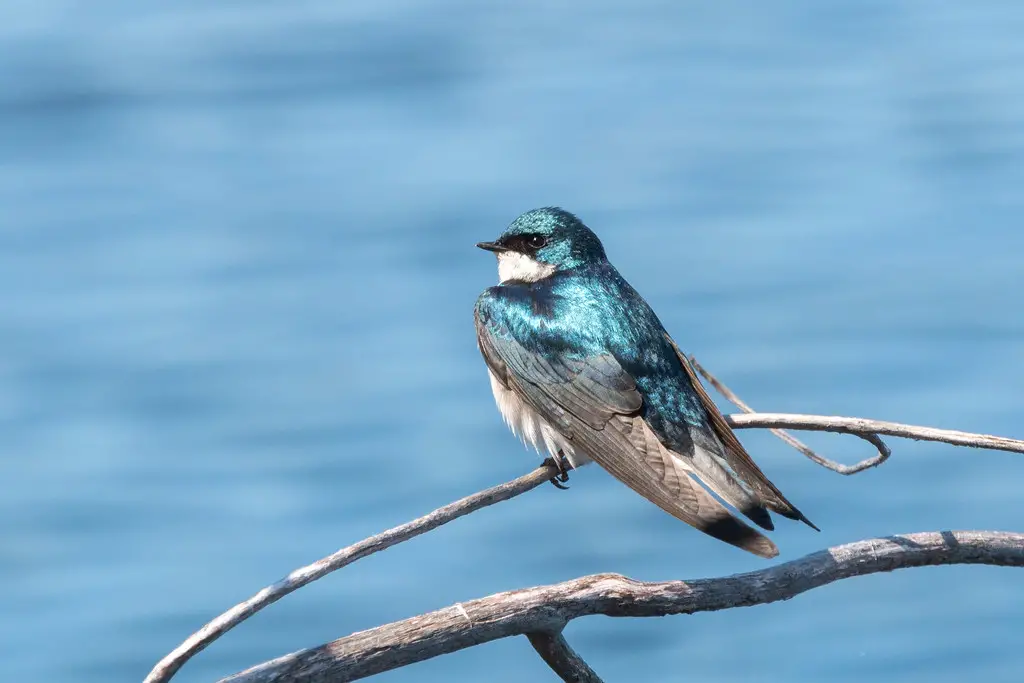
Image Source
- Scientific name: Tachycineta bicolor
- Lifespan: 5 years
- Size: 14 cm
- Native to: North America
The Tree Swallow is a small bird, measuring about 5-6 inches in length. These birds have a distinct appearance, featuring dark metallic blue to blue-green feathers with a white belly. They also have notched tails and pointed wingtips. While the males exhibit these vibrant colors, female Tree Swallows share a similar appearance but tend to be a bit duller in coloring.
When it comes to their diet, Tree Swallows primarily feed on insects and small fruits, which they catch while in flight.
Although they are not typically seen at bird feeders, Tree Swallows prefer open areas such as fields, large lawns, and marshes for foraging and nesting.
Speaking of nesting, Tree Swallows are cavity nesters. They often choose to nest in old, dead trees or existing holes left behind by other cavity-nesting birds. During the breeding season, they lay 2-8 eggs. These eggs start with a light pink color and gradually fade to white. The incubation period for these eggs lasts for approximately 14-15 days, and the young Tree Swallows, or fledglings, typically leave the nest at about 18-22 days of age.
White-breasted Nuthatch

Image Source
- Scientific name: Sitta carolinensis
- Lifespan: 2-6 years
- Size: 13-15 centimeters (5-6 inches)
- Origin: North America
The White-Breasted Nuthatch is a small bird, typically measuring between 5 to 6 inches in length. These birds have a distinct appearance with a gray-blue back, a white head adorned with a black cap, and a chestnut-colored area under their tail. They also possess a long, thin, pick-like beak. Female White-Breasted Nuthatches share a similar look, except their cap and neck are gray. These nuthatches are often observed climbing upside-down on deciduous trees as they search for insects beneath the tree bark.
When it comes to their diet, White-Breasted Nuthatches primarily feed on insects and seeds.
While they may not be frequent visitors to bird feeders, you can attract White-Breasted Nuthatches by offering suet, sunflower seeds, and shelled peanuts as feeder food.
White-Breasted Nuthatches tend to reside in habitats near mature deciduous and mixed forests, as well as wooded suburban areas such as orchards, parks, and backyards.
For nesting, White-Breasted Nuthatches are cavity nesters. They typically have one brood per breeding season, consisting of 5-9 eggs. These eggs are white with brown markings. The incubation period for these eggs lasts for approximately 11-12 days, and the young nuthatches fledge at about 13-14 days of age.
Unlike migratory birds, White-Breasted Nuthatches do not undertake seasonal migrations. They remain in their year-round range throughout all seasons of the year. However, a small portion of the population may migrate to a strip in the south-central United States for the winter months. Their year-round range includes every U.S. state, Canada’s southern provinces, and Mexico.
Final Thoughts on Blue Birds in New Hampshire
Bluebirds in New Hampshire are not only captivating and charming birds but also important indicators of the health of our local ecosystems. Their presence reminds us of the delicate balance of nature and our role in preserving it. By supporting conservation efforts, providing suitable nesting spaces, and being mindful of our environmental impact, we can help ensure that these beautiful blue birds continue to thrive in New Hampshire.

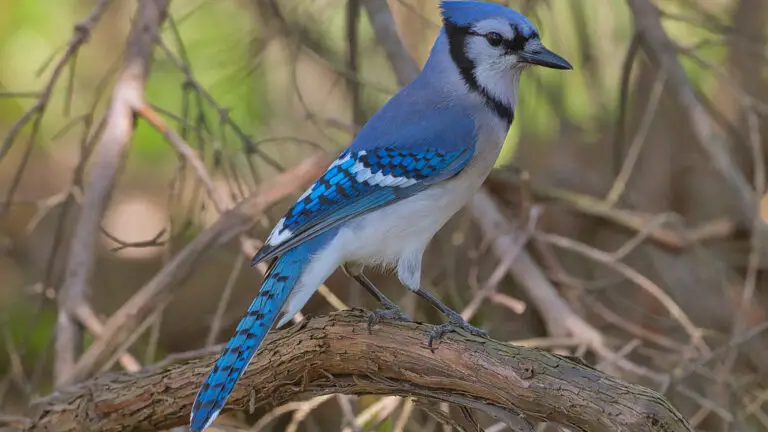
![8 Species Of Hawks In New York [Images + Ids]](https://birdsology.com/wp-content/uploads/2023/02/22988829524_d7315189e5_b-600x400.jpg)
![13 Beautiful Blue Birds in Massachusetts [Images + IDs]](https://birdsology.com/wp-content/uploads/2023/09/52109509501_22164e9350_b-600x400.jpg)
![10 Beautiful Red Birds in South Carolina [Images + IDs]](https://birdsology.com/wp-content/uploads/2023/03/14235697222_3abaaf211f_b-600x400.jpg)
